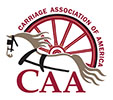Tips from Beth Brady for Cleaning Wicker Carriages and Carriage Accessories
Our wheeled artisan heritage is valuable and deserves to be preserved. Here, I’ll share some tips for cleaning and caring for your wicker carriage parts.
The term “wicker” refers to articles that have been woven. Rattan and willow were the most commonly used raw materials in making woven articles for the carriage-building and restoration trades. But a wide variety of alternate products, including synthetic materials and, after 1917, paper fiber, was used as well.
Before washing any woven carriage parts, carefully inspect and evaluate them, particularly those made after 1917. If you can, you’ll want to find out the raw material that was used, and the finish that was applied, as this will help determine any specific maintenance requirements. Don’t forget to also regularly clean and maintain any other woven articles in your collection, such as imperials, coach-horn cases, umbrella / cane baskets, and wheel guards.
In most cases, these general cleaning and maintenance tips will be useful.
To clean natural-material woven carriage parts: If the woven parts are in good condition, use a vacuum or power blower to remove any dirt and dust. Then, clean the wicker with Murphy’s Oil Soap and water.
To remove mold or mildew: Mix a light solution of bleach and water, and apply the solution using a spray bottle. Let the wicker air dry, out of direct sunlight. You may need to repeat this process.
To clean paper-fiber surfaces: Moisten the surface very slightly with distilled or de-ionized water, which will hold onto the dust particles so you can more easily pick them up.
To store your wicker vehicle: Be sure that temperature and humidity levels in your carriage house are kept level, as high humidity will subject rattan to mold. Use a light weight, breathable dust cover to protect your vehicle from sunlight and to help keep dust off the wicker.
Written by Beth Brady for the August 2012 edition of The Carriage Journal.

